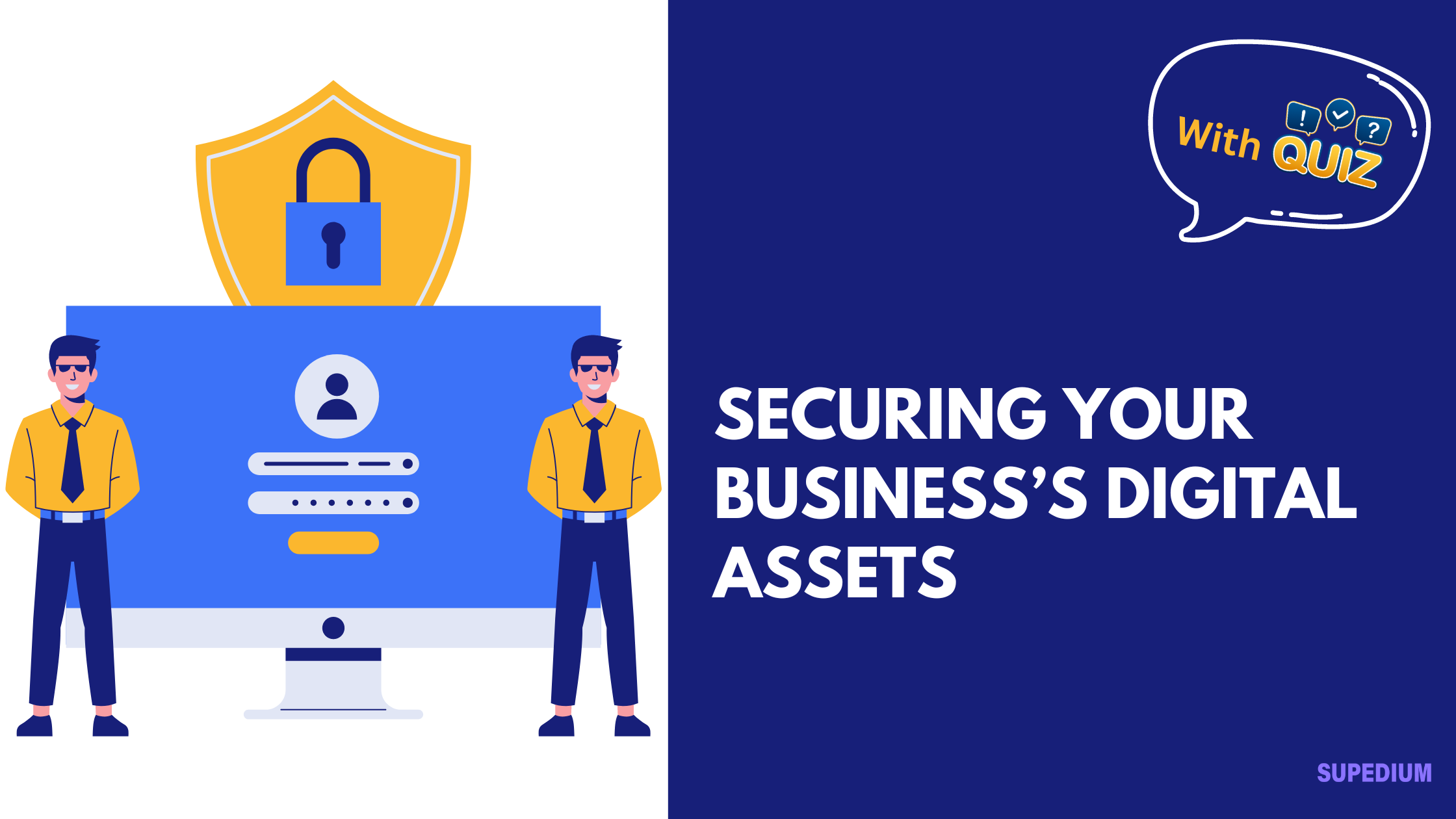Table of Contents
![]()
In an increasingly digital world, securing your business’s digital assets is not just a technical necessity but a strategic imperative. Digital assets include everything from intellectual property and sensitive data to software and cloud storage. Effective protection of these assets is crucial for maintaining business integrity, ensuring customer trust, and meeting regulatory requirements. This article will guide you through the key aspects of securing your digital assets, including understanding threats, implementing security measures, and complying with legal standards.
Understanding Threats and Vulnerabilities
To safeguard your digital assets, you first need to understand the threats and vulnerabilities that could compromise them.
Common Threats
- Cyberattacks: These include various forms of malicious activities such as phishing, ransomware, and malware. Phishing attempts to deceive individuals into divulging confidential information, while ransomware locks data until a ransom is paid. Malware, including viruses and spyware, can damage or steal data.
- Insider Threats: These can come from current or former employees who may intentionally or unintentionally compromise security. Examples include disgruntled employees who sabotage systems or employees who inadvertently expose data through careless behavior.
- Physical Threats: While often overlooked, physical threats such as theft, natural disasters, or accidents can also impact digital assets. Unauthorized physical access to hardware or servers can result in data breaches or loss.
Vulnerabilities
- Software and System Weaknesses: Outdated or unpatched software can be exploited by attackers. Vulnerabilities in operating systems, applications, or network configurations can provide entry points for unauthorized access.
- Human Error: Mistakes such as misconfigured security settings or accidental data sharing can create significant risks. Employees may inadvertently expose sensitive information or fail to follow security protocols.
- Network Configuration Issues: Poorly configured networks can be vulnerable to attacks. Issues such as open ports or weak firewall rules can expose your systems to threats.
Risk Assessment and Management
Once you understand potential threats and vulnerabilities, the next step is conducting a risk assessment and developing a risk management plan.
Conducting a Risk Assessment
- Identifying Critical Assets: Start by cataloging your digital assets. This includes databases, intellectual property, financial records, software, and cloud storage. Understanding what assets are critical to your business operations will help prioritize security efforts.
- Evaluating Potential Risks: Assess the likelihood and impact of different threats to your assets. For example, evaluate the risk of a ransomware attack on your financial records compared to the risk of a physical theft of hardware.
- Analyzing Impact and Likelihood: Determine how severe the impact would be if a particular risk were realized and how likely it is to occur. This analysis helps in prioritizing which risks to address first.
Developing a Risk Management Plan
- Risk Mitigation Strategies: Implement measures to reduce or eliminate identified risks. This could include upgrading software, training employees, or enhancing physical security.
- Prioritizing Risks: Focus on the risks that have the highest potential impact and likelihood. Allocate resources to mitigate these high-priority risks first.
- Implementing Controls and Safeguards: Put in place security controls such as firewalls, encryption, and access controls to protect your digital assets.
Security Measures and Best Practices
Effective security measures are essential for protecting your digital assets. Here are some best practices:
Data Protection
- Encryption: Use encryption to protect data both at rest (stored data) and in transit (data being transmitted over networks). Encryption ensures that even if data is intercepted or accessed, it remains unreadable without the appropriate decryption key.
- Regular Data Backups: Implement a robust data backup strategy to ensure that you can recover your data in case of loss or corruption. Regularly test backups to ensure they work and that you can quickly restore your systems.
- Data Masking and Anonymization: For sensitive data, consider data masking (replacing sensitive data with fictional but realistic values) and anonymization (removing personal identifiers) to reduce the impact of a data breach.
Access Controls
- User Authentication: Use strong authentication methods such as multi-factor authentication (MFA) to verify user identities. MFA requires users to provide multiple forms of verification before accessing systems.
- Role-Based Access Control: Implement role-based access control (RBAC) to ensure users only have access to the data and systems necessary for their roles. This reduces the risk of unauthorized access.
- Regular Access Reviews: Periodically review and update access permissions to ensure that they are appropriate and reflect current job responsibilities.
Network Security
- Firewalls and Intrusion Detection Systems: Deploy firewalls to filter incoming and outgoing traffic based on security rules. Intrusion Detection Systems (IDS) can monitor network traffic for suspicious activity and alert you to potential threats.
- Secure Wi-Fi Networks: Use strong encryption (e.g., WPA3) for Wi-Fi networks and implement network segmentation to isolate sensitive data from other parts of your network.
- VPNs and Secure Remote Access: Use Virtual Private Networks (VPNs) to secure remote access to your network. Ensure that remote access is limited to authorized users and is monitored for unusual activity.
Endpoint Security
- Antivirus and Anti-Malware Software: Install and regularly update antivirus and anti-malware software on all endpoints (e.g., computers, mobile devices) to protect against malicious software.
- Regular Updates and Patching: Ensure that all software, including operating systems and applications, is regularly updated to patch vulnerabilities and improve security.
- Device Management Policies: Implement policies for managing and securing devices, including guidelines for mobile device use and procedures for handling lost or stolen devices.
Incident Response and Management
Having a plan for responding to security incidents is crucial for minimizing damage and recovering quickly.
Developing an Incident Response Plan
- Incident Detection and Reporting: Establish procedures for detecting and reporting security incidents. Ensure that employees know how to report suspicious activity and whom to contact.
- Response Procedures and Responsibilities: Define the steps to take when an incident occurs, including containment, eradication, and recovery procedures. Assign specific roles and responsibilities to team members involved in incident response.
- Communication Strategies: Develop a communication plan for informing stakeholders, including customers, employees, and regulatory bodies, about the incident. Clear and timely communication helps manage the situation effectively and maintains trust.
Handling Security Incidents
- Containment and Eradication: Take immediate action to contain the incident and prevent further damage. Remove any malicious software and close vulnerabilities to stop the threat from spreading.
- Recovery and Restoration: Restore affected systems and services to normal operation. Verify that systems are secure and functioning correctly before resuming normal activities.
- Post-Incident Analysis and Improvement: Conduct a thorough analysis of the incident to understand what happened and why. Use this information to improve security measures and update incident response plans.
Compliance and Legal Considerations
Compliance with legal and regulatory requirements is essential for protecting digital assets and avoiding legal repercussions.
Relevant Regulations and Standards
- GDPR (General Data Protection Regulation): This European regulation requires businesses to protect personal data and privacy. It mandates data protection measures, breach notification requirements, and rights for individuals regarding their data.
- CCPA (California Consumer Privacy Act): This law provides California residents with rights over their personal data, including the right to access, delete, and opt-out of the sale of their data.
- HIPAA (Health Insurance Portability and Accountability Act): HIPAA sets standards for protecting sensitive patient information in the healthcare industry, including requirements for data security and privacy.
- ISO/IEC 27001: This international standard provides a framework for establishing, implementing, maintaining, and continuously improving information security management systems (ISMS).
Legal Responsibilities
- Data Breach Notification Requirements: Many regulations require businesses to notify affected individuals and authorities in the event of a data breach. Ensure that you are aware of and comply with these requirements.
- Contractual Obligations with Clients and Vendors: Review and adhere to contractual obligations related to data protection and security. This includes agreements with third parties who handle your data.
- Record-Keeping and Documentation: Maintain thorough records of security policies, procedures, and incidents. Proper documentation is essential for compliance and for demonstrating your commitment to security.
Employee Training and Awareness
Employees play a crucial role in protecting digital assets. Effective training and awareness programs are essential for minimizing risks.
Importance of Cybersecurity Training
- Recognizing Phishing and Social Engineering Attacks: Train employees to identify and respond to phishing emails and social engineering tactics that attempt to deceive them into revealing sensitive information.
- Safe Internet Practices: Educate employees about safe browsing habits, the risks of downloading unverified software, and the importance of using strong, unique passwords.
- Proper Data Handling Procedures: Ensure that employees understand and follow procedures for handling sensitive data, including data classification, storage, and transmission practices.
Regular Training Programs
- Onboarding and Continuous Education: Include cybersecurity training as part of the onboarding process for new employees. Provide ongoing training to keep employees updated on the latest threats and best practices.
- Simulated Attacks and Drills: Conduct regular simulated phishing attacks and security drills to test employee awareness and response. Use the results to identify areas for improvement.
- Updates on Emerging Threats: Keep employees informed about new and evolving threats. Regular updates help employees stay vigilant and adapt to changing security challenges.
Monitoring and Continuous Improvement
Security is an ongoing process that requires regular monitoring and improvement.
Implementing Monitoring Tools
- Security Information and Event Management (SIEM): SIEM systems collect and analyze security data from across your network to detect and respond to potential threats in real-time.
- Regular Security Audits: Conduct periodic security audits to assess the effectiveness of your security measures. Identify and address any gaps or weaknesses.
- Automated Threat Detection Systems: Use automated tools to monitor network traffic and system activity for signs of malicious behavior or anomalies.
Continuous Improvement
- Reviewing and Updating Security Policies: Regularly review and update your security policies and procedures to reflect changes in technology, threats, and regulations.
- Learning from Incidents and Breaches: Analyze past incidents and breaches to understand their causes and impacts. Use this information to enhance your security posture and prevent future occurrences.
- Adapting to Emerging Threats and Technologies: Stay informed about emerging threats and new security technologies. Adapt your security strategy to address evolving risks and leverage new tools for better protection.
Conclusion
Securing your business’s digital assets is a multifaceted endeavor that involves understanding threats, implementing effective measures, and staying compliant with regulations. By conducting thorough risk assessments, deploying robust security controls, and continuously improving your security practices, you can protect your digital assets from potential threats and ensure the long-term success of your business. In today’s digital landscape, proactive security measures are not just a best practice—they are a necessity for safeguarding your business’s future.






Be the first to comment